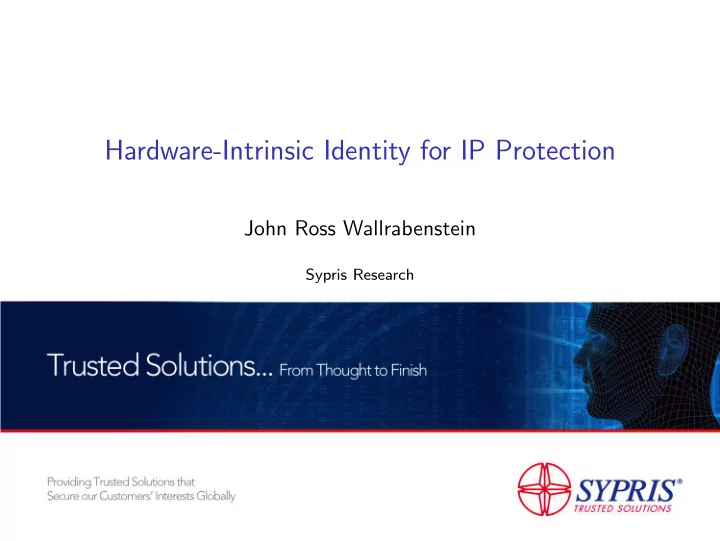

Hardware-Intrinsic Identity for IP Protection John Ross Wallrabenstein Sypris Research
Sypris Electronics
Digital Supply Chain Security ◮ How is digital information shared securely?
Digital Supply Chain Security ◮ How is digital information shared securely? ◮ Cryptography
Digital Supply Chain Security ◮ How is digital information shared securely? ◮ Cryptography ◮ What prevents an adversary from intercepting the information?
Digital Supply Chain Security ◮ How is digital information shared securely? ◮ Cryptography ◮ What prevents an adversary from intercepting the information? ◮ Assumption: Adversary cannot obtain private key of recipient
Identity: Traditional Cryptographic Systems ◮ Symmetric Private Key Stored on Drive
Identity: Traditional Cryptographic Systems ◮ Asymmetric Private Key Stored on Drive
Powerful Adversaries
Identity: Traditional Approach Limitations ◮ Identity is Stored
Secure Hardware Solutions ◮ Secure Hardware ◮ Rugged Enclosure ◮ Tamper Resistance ◮ Epoxy Coating ◮ Battery Hold-Up ◮ Limitations ◮ Size & Weight ◮ $$$
PUF-Based Identity Management ◮ Identity is Dynamically Regenerated As Needed
Physical Unclonable Functions ◮ A PUF is input a challenge , and outputs a response ◮ Mapping based on unique physical characteristics of device ◮ PUFs on different devices will return different responses for the same challenge
Core PUF Features ◮ Identity Management: Extract identity intrinsically linked to hardware ◮ Tamper Detection: Detect hardware tampering after trusted enrollment ◮ Key Management: Private key regenerated as needed, rather than stored Key Generation Key Operations τ Traditional Cryptography τ PUF-Based System ε ε
Identity 0010100101101011011010010010111010 1001011010011011011110001010011101 0010100010100101010101010100100101 0010110110101001110111101000010110 ACCEPT 10101101000101101000101101101110110 0101101110100101010111100101100011 Identical Different Challenge Responses 0010100101101011011010010010111010 10110011011000111011111011100110101 PUF 0010100010100101010101010100100101 0010110101011011101010101010100101 REJECT 10101101000101101000101101101110110 0110100101101010011010101010100100 Core Concept: Identically manufactured devices have different hardware identities
Tamper Detection 0010100101101011011010010010111010 1001011010011011011110001010011101 0010100010100101010101010100100101 0010110110101001110111101000010110 ACCEPT 10101101000101101000101101101110110 0101101110100101010111100101100011 Identical Different Challenge Responses 0010100101101011011010010010111010 10110011011000111011111011100110101 PUF 0010100010100101010101010100100101 0010110101011011101010101010100101 REJECT 10101101000101101000101101101110110 0110100101101010011010101010100100 FPGA Tampering Changes PUF Mapping Core Concept: Hardware tampering fundamentally changes hardware identity
Key Properties ◮ Resilience to Compromise: No secret information is stored at either the device or server: ◮ A device does not have any sensitive information stored in nonvolatile memory: the private key is dynamically regenerated as needed. ◮ A server only stores the public keys of the devices. ◮ Resilience to Tampering: ◮ Tampering (e.g., probing, modification) alters the unique characteristics of the hardware ◮ Prevents the PUF from extracting the original identity of the device
Deploying PUFs in Practice ◮ PUFs (like human biometrics) have noisy output ◮ What if error correction ”corrects” a different device’s response? ◮ What is the false positive and false negative rate? ◮ PUFs rely on slight manufacturing variations ◮ How will fluctuations in temperature/voltage/etc. affect the response?
Overlapping Distributions
Separate Distributions
Experimentally Observed Distributions
Deploying PUFs in Practice ◮ PUFs have noisy output ◮ What if error correction ”corrects” a different device’s response? ◮ Experimental results suggest this occurs with only negligible probability ◮ What is the false positive and false negative rate? ◮ 0% in practice ◮ Likely only under rapid and substantial variation ◮ PUFs rely on slight manufacturing variations ◮ How will fluctuations in temperature/voltage/etc. affect the response? ◮ Xilinx board placed in a temperature chamber ◮ Varied from 0 − 60 ◦ C ◮ PUF output shift of ≈ 5 − 10 bits
PUF-Based Benefits for PLM Solutions ◮ Hardware-Intrinsic Identity: Guarantee recipient has a specific piece of hardware ◮ Tamper Detection: Guarantee no adversarial tampering with recipient hardware ◮ Key Management: Guarantee an adversary cannot extract private key from recipient hardware
Discussion Questions
Recommend
More recommend